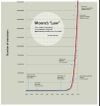2015: Moore’s “Law” prevails for 50 years
Projection drove advances in semiconductor and magnetic storage




In April 1965, Electronics magazine published an article by Gordon E. Moore, Director of R&D at Fairchild Semiconductor that estimated the growth in the complexity of integrated circuits over the next ten years. He forecast that “by 1975 economics may dictate squeezing as many as 65,000 components on a single silicon chip.” This required a doubling every 12 months. In 1975, Moore reported that advances in photolithography, wafer size, process technology, and “circuit and device cleverness,” had allowed his projection to be realized.
On revisiting his projection with new data at that time, Moore modified the future rate of increase in the number of transistors on a chip to “a doubling every two years, rather than every year.” Originally intended to encourage his customers to adopt the most advanced technology in their new computer designs, his prediction emerged as a self-fulfilling prophecy. Dubbed Moore’s “Law,” semiconductor companies perceived it as a benchmark they must adhere to in order to stay ahead of the competition.
Even as Moore commented in 2003 that “No exponential change continues forever,” his revised prediction has prevailed. From 1971 (Intel 4004, 2,300 transistors) to 2015 (Nvidia Titan, 8,000,000,000), the number of transistors on the largest commercial microprocessor (MPU) devices increased at a compound annual growth (CAGR) rate of 41%. From 2,000 bits/sq. in. in 1957 (IBM RAMAC) to 1 trillion in 2015, commercial hard disk-drive (HDD) products have increased in areal density at a comparable CAGR to that of Moore’s Law for semiconductor devices. For HDDs, where operation depends on mechanical movement of the rotating disk and head track actuator, the improvement in speed performance however has greatly lagged the above CAGR values. These mechanical limitations have contributed to making SSDs attractive as HDD replacements in high performance applications. Efforts to produce ever faster and denser SSD solutions includes research into approaches as diverse as Phase Change Memory (PCM), ReRAM/RRAM, and carbon nanotubes.
Contemporary Documents
- Moore, Gordon E. “Cramming more components onto integrated circuits” Electronics, McGraw Hill, Inc. (Vol. 38, No.8, April 19, 1965)
- Moore, Gordon. “Progress in Digital Integrated Electronics” IEEE, IEDM Tech Digest (1975) pp.11-13
- Moore, Gordon. “Lithography and the Future of Moore’s Law” Proceedings of SPIE (Vol: 2437 May 1995)
- Moore, Gordon E. “No Exponential Is Forever: but ‘Forever’ Can Be Delayed!” Solid-State Circuits Conference, 2003. ISSCC Digest of Technical Papers (February 13, 2003) pp: 20-21
More Information
- “Memory and Storage: Ever More Dense”) Revolution Exhibition: Memory and Storage Gallery, Computer History Museum (2011)
- “Moore’s Law” Revolution Exhibition: Digital Logic Gallery, Computer History Museum (2011)
- "1965 – "Moore's Law" Predicts the Future of Integrated Circuits" The Silicon Engine, Computer History Museum (2007)
- Laws, David A. “Moore’s Law@50: The most important graph in human history” Computer History Museum @CHM (April 15, 2015)
- Alba, Davey. “50 Years On, Moore’s Law Still Pushes Tech to Double Down” Wired (April 15, 2015)
- Thackray, Arnold, David Brock, Rachel Jones. Moore’s Law, Basic Books, New York (2015)
- “50 Years of Moore’s Law” Intel Corporation (April 2015) (Retrieved on 5.7.15 from: http://www.intel.com/content/www/us/en/silicon-innovations/moores-law-technology.html)
Oral Histories
- "Moore, Gordon (Shockley, Fairchild, Intel), an oral history" Computer History Museum Oral History # 102658233 (2008-1-25)
- "Intel oral history panel : Gordon Moore and Arthur Rock" Computer History Museum Oral History # 102739934 (2014-07-09)
- "Moore, Gordon E. Electrical Engineer, an oral history conducted in 1976 by Michael Wolff" IEEE History Center, Rutgers University, New Brunswick, NJ, USA.
2015_Moore_v6
Rev:6.3.18


